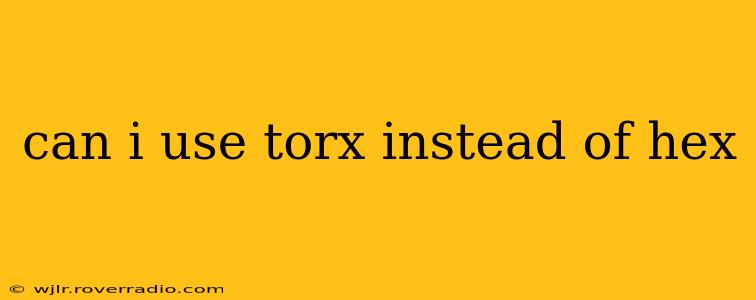Can I Use Torx Instead of Hex? A Comprehensive Guide
The simple answer is: usually not, and definitely not safely. While both Torx and hex (or Allen) screws are used to fasten components, they have different designs and are not interchangeable. Trying to force a Torx driver into a hex screw or vice versa will likely damage both the screw and the driver. This can lead to stripped screws, broken tools, and potentially injury.
Let's delve deeper into the reasons why direct substitution isn't possible and explore some exceptions.
What are Torx and Hex Screws?
-
Hex Screws (Allen Screws): These screws have a hexagonal (six-sided) recess in the screw head. They're incredibly common in many applications, from furniture assembly to mechanical engineering. The simple design makes them relatively inexpensive to manufacture.
-
Torx Screws (Star Screws): These screws feature a six-pointed star-shaped recess. The design offers several advantages over hex screws, including:
- Increased torque transfer: This means you can tighten the screw more securely without stripping the head.
- Reduced cam-out: The star shape minimizes the chance of the driver slipping out of the screw head during tightening or loosening.
- Better resistance to wear: The larger contact area between the driver and screw head leads to less wear and tear.
Why You Can't Directly Substitute Torx and Hex
The fundamental reason you can't substitute is the difference in shape and size of the recesses. A Torx driver simply won't fit into a hex screw and applying force will inevitably damage the screw head. Similarly, a hex key will not correctly engage with a Torx screw, leading to slipping and potential damage. The risk of stripping the screw head is significantly higher when using the wrong type of driver.
Are There Any Exceptions?
While direct substitution is generally not recommended, there are a few very specific scenarios where you might be able to get away with it, but proceed with extreme caution:
- Extremely Loose Screws: If a screw is already very loose and you're just trying to nudge it a tiny bit further, and you're absolutely certain of the size, you might be able to use a slightly oversized driver as a temporary solution. However, the risk of damage is still high. This should be considered a last resort only.
- Similar Size and Shape (with extreme caution): In incredibly rare cases, you might find a very small hex screw that barely fits into a Torx driver, and vice versa. However, you'll almost certainly experience slipping and potential damage even in this scenario. We strongly advise against this.
What to Do Instead?
If you need to remove or install a screw and don't have the correct driver, your best bet is to find the right tool. Hardware stores usually carry a wide selection of both Torx and hex drivers. You can also find sets online that include various sizes of both types.
Other Frequently Asked Questions
H2: What if I strip a screw head?
Stripped screws are a common problem. If this happens, you'll likely need to use specialized tools to remove them, such as screw extractors or a specialized drill bit. In severe cases, the screw may need to be drilled out entirely.
H2: What is the difference between Torx Plus and Torx Security?
Torx Plus screws have a slightly different shape than standard Torx screws, offering improved cam-out resistance. Torx Security screws have a pin in the center of the star, requiring a special security driver to prevent unauthorized access. These are not interchangeable with standard Torx or hex screws.
In conclusion, while the temptation to use a substitute might exist, the risks involved greatly outweigh any potential benefits. Using the correct driver is essential for ensuring safe and efficient work. Always prioritize using the appropriate tool for the job.
